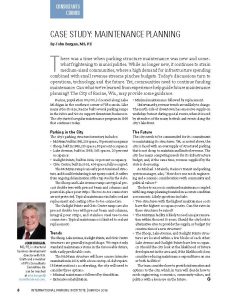While most, if not all, subscribers to The Parking Professional magazine are well aware of the Lighting Energy Efficiency in Parking (LEEP) campaign, it’s a safe bet they’ve never heard of Ventilation Energy Efficiency in Parking (VEEP). Consider this, then, a first step in heralding the benefits of a proposed and valuable program for parking industry members.
Much like LEEP, the the VEEP campaign would recognize and guide commercial property owners to enable commercial property owners and managers to take advantage of savings opportunities from high efficiency ventilation solutions in their parking facilities.
The Foundation
Research conducted by Nagle Energy Solutions (NES) and delivered to the U.S. Department of Energy and the LEEP Campaign organizers makes a compelling case for auditing and potentially upgrading mechanical ventilation systems in parking facilities. The information verified that along with lighting, mechanical ventilation systems are a significant source of energy consumption and operational costs for an enclosed, commercial garage.
Commercial garage owners and operators must adhere to the International Mechanical Code (IMC) and the American Society of Heating, Refrigeration and Air Conditioning (ASHRAE) requirement to continuously ventilate their properties during occupied hours, except when they deploy sensor-based means of control. For a garage without a sensor-based system, that means up to two-thirds of its monthly or annual utility bill can be
dedicated to ventilating the garage, with the remaining one-third spent on lighting and other systems.
Several recent case studies illustrate that new and innovative ventilation-control technology is capable of reducing not only the garage ventilation system’s kilowatt- hour (kWh) consumption and peak kilowatt (kW) demand by up to 97 percent but an entire commercial property’s energy consumption by as much as 45 percent.
Case Study
To place this in real terms, consider the example of the Main Street Cupertino development, a mixed-use neighborhood in the heart of Silicon Valley with a 1,370-space garage.
Detailed calculations at the time of the garage’s construction revealed that with no means of control in place and running on a 24/7 basis, the garage ventilation system would consume approximately 527,000 kWh per year, with a correlating peak kW demand greater than 60 kW. At a utility rate of $0.205 per kWh, the developer’s annual cost to ventilate the garage would amount to slightly more than $108,000 (or $9,000 per month).
Yet with contemporary garage ventilation technology controlling continuous ventilation of the Main Street garage, annual kWh consumption was reduced by 500,559 kWh and peak kW demand by 58.59 kW. That’s a 97.4 percent savings. As a result, annual utility fees for ventilating the space have been limited to roughly $5,400—the equivalent of reducing energy costs by more than $102,500 a year (or by $8,500 per month).
VEEP
Consideration is being given to aligning VEEP with the LEEP campaign, but given that it’s in the development stage, it’s too early to know in what form or manner.
IPI members attending the IPI Conference & Expo in Nashville, Tenn., in May (IPIConference.parking.org) can attend a presentation further outlining new garage ventilation technology systems that provide a smarter, more capable, and adaptable means for ventilating commercial garages.
FRANK NAGLE is president of Nagle Energy Solutions and a member of IPI’s Sustainability
Committee. He can be reached at frank@nagle-energy.com.
TPP-2016-03 VEEP: Evaluating Ventilation Efficiency

